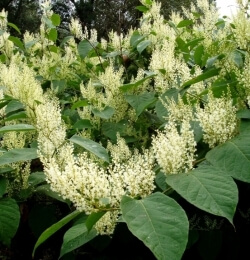
Polygonum cuspidatum
Japanese knotweed brochure (PDF)
Why is Japanese knotweed a problem?
Japanese knotweed forms dense stands that invade riparian areas, crowd out all other vegetation and degrade wildlife habitat.
It also creates a fire hazard in the dormant season and is difficult to control once established.
Japanese knotweed reproduces by seed and rhizome production and is often found on stream banks and disturbed areas.
Recommendations for controlling knotweed
Recognizing Japanese knotweed
Japanese knotweed that was brought to this country during the 19th century as an ornamental plant. It is an aggressive weed that can spread quickly and alter the existing environment.
Japanese knotweed is a perennial species with spreading rhizomes and numerous reddish-brown, freely branched stems.
Plants can reach 6 to 12 feet tall. Leaves are oblong, sometimes heart shaped and alternately arranged. Flowers are in panicles and usually white with a green tint.
Stems are green, hard, hollow, jointed and swollen at nodes.
